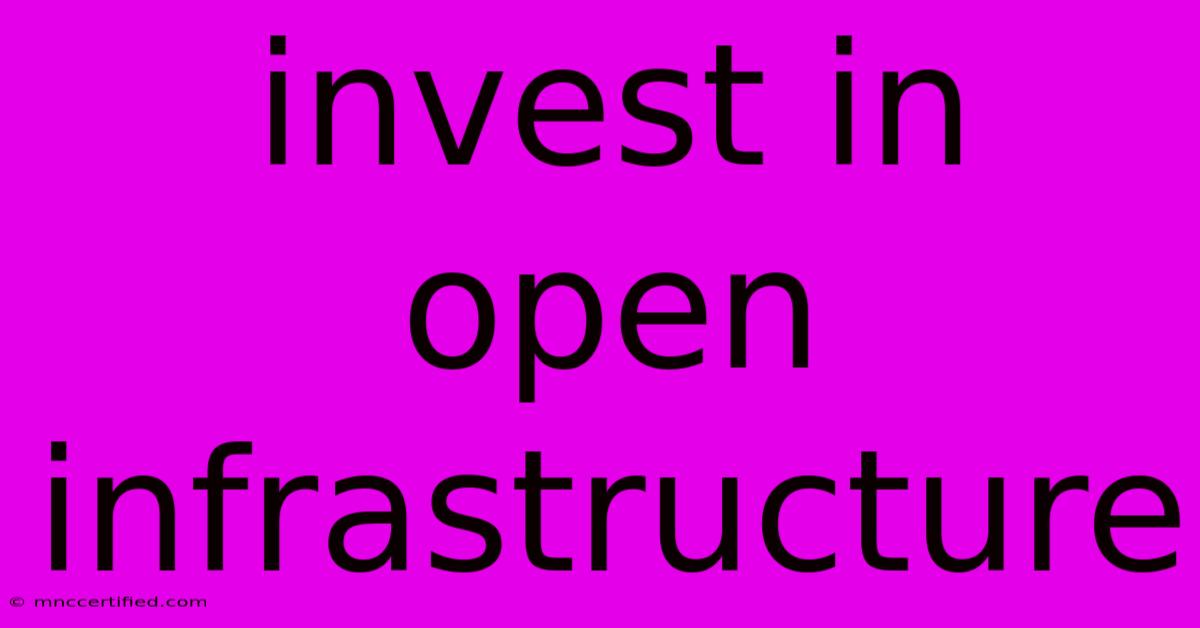Invest In Open Infrastructure

Table of Contents
Invest in Open Infrastructure: A Smart Strategy for the Future
The digital landscape is evolving rapidly, demanding robust, adaptable, and cost-effective infrastructure. This is where open infrastructure emerges as a compelling solution, offering significant advantages over proprietary alternatives. Investing in open infrastructure isn't just a trend; it's a strategic move that can unlock innovation, reduce costs, and bolster security for businesses of all sizes. This article delves into the key reasons why investing in open infrastructure is a smart choice for the future.
What is Open Infrastructure?
Open infrastructure refers to technology systems built on open-source software, hardware designs, and standards. Unlike proprietary systems locked into a single vendor's ecosystem, open infrastructure fosters collaboration, transparency, and interoperability. This means you have greater control over your systems, access to a wider range of choices, and the ability to customize solutions to perfectly fit your needs. Key components of open infrastructure include:
- Open-source software: Utilizing software with publicly accessible source code allows for community-driven improvements, enhanced security through collaborative auditing, and freedom from vendor lock-in. Examples include Linux, OpenStack, and Kubernetes.
- Open standards: Adherence to open standards ensures interoperability between different components and vendors, preventing vendor lock-in and fostering a more flexible and adaptable system.
- Open hardware: While less common than open-source software, open hardware designs offer similar benefits, allowing for greater customization and avoiding reliance on a single hardware provider.
Why Invest in Open Infrastructure?
Investing in open infrastructure offers a multitude of advantages, impacting several key aspects of your business:
1. Reduced Costs
Lower upfront costs: Open-source software is typically free to use, significantly reducing initial investment compared to proprietary solutions. While you'll still incur costs for hardware, support, and implementation, these are often lower than with proprietary systems.
Reduced long-term expenses: The freedom from vendor lock-in means you can choose the best solutions from a wider range of providers, often leading to better pricing and more competitive bids. You also have more flexibility to adapt your infrastructure as your needs evolve without being constrained by a single vendor's roadmap.
2. Enhanced Security
Increased transparency and community scrutiny: Open-source software benefits from a large community of developers and security researchers who actively scrutinize the code for vulnerabilities. This collaborative approach often leads to quicker identification and patching of security flaws compared to proprietary systems where security issues may remain hidden.
Greater control and customization: Having access to the source code allows for better customization of security measures, tailoring your infrastructure to your specific security needs and vulnerabilities.
3. Improved Flexibility and Scalability
Adaptability to changing needs: Open infrastructure’s modularity and interoperability allow for easy scaling and adaptation to changing business demands. You can add or remove components as needed, ensuring your infrastructure remains optimized for your current workloads.
Innovation and customization: The ability to integrate different open-source components allows for greater innovation and customization, enabling you to build unique solutions that perfectly align with your specific business requirements.
4. Vendor Independence
Freedom from vendor lock-in: Open infrastructure liberates you from the constraints of a single vendor. This means you aren't tied to a specific vendor's pricing, roadmap, or support policies. You have greater freedom to choose the best solutions and providers based on your needs and preferences.
Getting Started with Open Infrastructure
Transitioning to open infrastructure requires careful planning and execution. Consider these steps:
- Assess your current infrastructure: Understand your current needs and limitations before choosing open-source alternatives.
- Identify suitable open-source solutions: Research and evaluate open-source options that meet your specific requirements.
- Develop a migration strategy: Plan a phased migration to minimize disruption to your business operations.
- Secure skilled personnel: You’ll need skilled professionals with expertise in open-source technologies to manage and maintain your infrastructure.
Conclusion: Embrace the Open Source Revolution
Investing in open infrastructure is a strategic decision that offers significant long-term benefits. By embracing open-source solutions, businesses can achieve greater cost savings, enhanced security, improved flexibility, and independence from proprietary vendors. While there might be an initial learning curve, the long-term advantages of open infrastructure far outweigh the challenges. It's time to embrace the open-source revolution and build a more resilient, adaptable, and cost-effective digital future.

Thank you for visiting our website wich cover about Invest In Open Infrastructure. We hope the information provided has been useful to you. Feel free to contact us if you have any questions or need further assistance. See you next time and dont miss to bookmark.
Featured Posts
-
Home Insurance Naples Florida
Nov 29, 2024
-
Typhoo Tea Seeks Administrators
Nov 29, 2024
-
Retail Gazette Homebase Acquisition Interest
Nov 29, 2024
-
Section 8 Investment Property
Nov 29, 2024
-
Madix Post Vpr Thanksgiving Parade
Nov 29, 2024